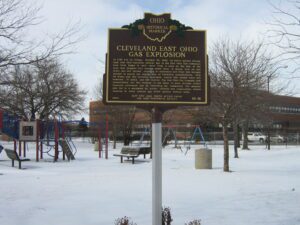, OH
At 2:30 p.m. on Friday, October 20, 1944, an above ground storage tank that held liquefied natural gas in the East Ohio Gas Company’s tank farm began to emit vapor from a seam on the side of the tank that dropped into nearby sewer lines. It mixed with air and sewer gas and ignited, resulting in explosions and fires that brought damage to nearly one square mile of Cleveland neighborhoods. With 79 homes and two factories destroyed, nearly 700 people were left homeless, 131 killed, and 225 injured. The East Ohio Gas Company took responsibility for this tragedy to aid those in need through direct financial assistance and by rebuilding the community. The disaster also led to a movement by public utilities and communities across America to store natural gas below ground without tanks.
, OH
In 1826, when Cleveland’s first cemetery closed, Cleveland village trustees paid Leonard Case Sr. one dollar for eight acres of land and dedicated it as the Erie Street Cemetery. Built on what became prime property, the cemetery touched off a century long struggle between residents and local government. In 1836, trustees allotted space in the cemetery for a gunpowder magazine and a poorhouse infirmary. Angry heirs of the original lot owners claimed infringement of covenant and sued Cleveland, but lost. During the early 1900s Mayor Tom Johnson’s administration tried to take back cemetery land and failed. Later pressure from the Pioneers’ Memorial Association and City Manager William Hopkins caused the planned Lorain Carnegie Bridge to avoid Erie Street Cemetery. Struggles to confiscate land ended, but the city neglected the cemetery. In 1939, The Early Settler’s Association restored the cemetery and erected a stone wall around it. (continued on other side)
, OH
Marine Colonel Robert F. Overmyer was born July 14, 1936 in Lorain, but always considered Westlake, where his family had lived since 1941, to be his hometown. He graduated from Westlake High School in 1954. After earning a bachelor’s degree in physics from Baldwin Wallace College in 1957, he entered active duty in the Marine Corps in 1958. He completed Navy flight training and was assigned to Marine Attack Squadron 214 in 1959. Overmyer logged over 7,500 flight hours, with more than 6,000 of those in jet aircraft. After earning a master’s degree in aeronautics from the U.S. Naval Postgraduate School in 1964, he was chosen as an astronaut for the USAF Manned Orbiting Laboratory Program in 1966. (Continued on other side)
, OH
City architect Frederic H. Betz designed the St. Clair Avenue Public Bath House and it was constructed in 1919-1920 at a cost of $320,000. The facility included a large gymnasium, swimming pool, and laundry, in addition to showers. City Council dedicated the newly completed building to the late, beloved Cleveland Indians shortstop Raymond Chapman in 1920. The St. Clair Recreation Center, as it was later known, was in the impact zone and survived the East Ohio Gas Company disaster on October 20, 1944. The facility was remodeled in 1949 and subsequent renovations demonstrate the utility of the building. Edward J. Kovacic (1910-1974) was the superintendent of the bathhouse from 1933-1934 and served on the City Council from 1940-1953. In 1977, the facility was renamed to honor Kovacic’s contributions to the citizens of the St. Clair neighborhood and to the city. (Continued on other side)





